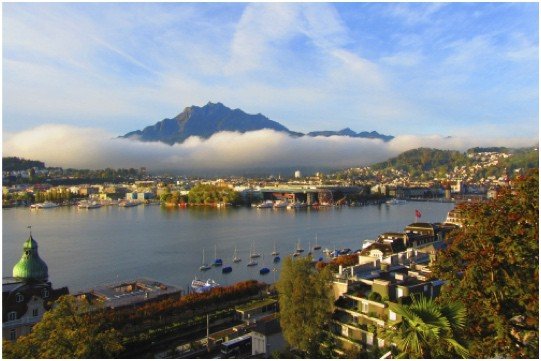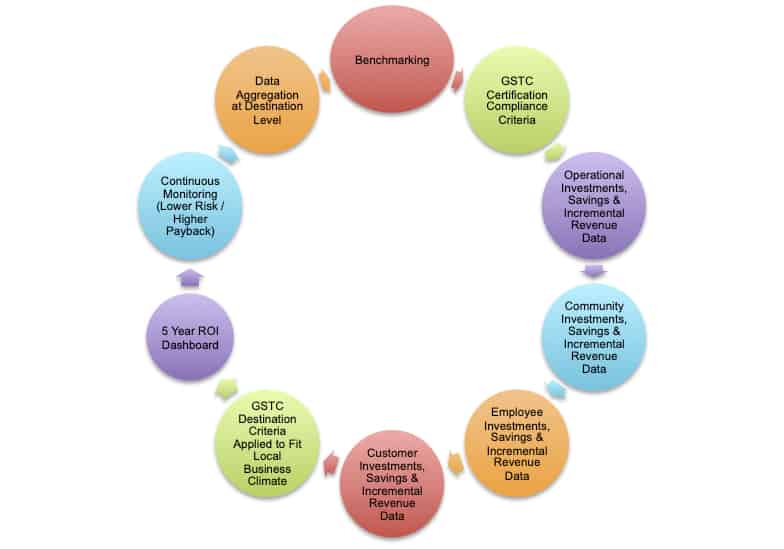Destination Stewardship Report – Autumn 2020 (Volume 1, Issue 2)
This post is from the Destination Stewardship Report (Autumn 2020, Volume 1, Issue 2), an e-quarterly publication that provides practical information and insights useful to anyone whose work or interests involve improving destination stewardship in a post-pandemic world.
Sustainable destination planning is frequently hobbled by conventional measures of return on investment. But if ROI is expanded by using data science to include tangible but often omitted factors at both company and destination levels, says Irene Lane, then the picture is more accurate – and brighter.
It’s Time To Merge Sustainable Destination Planning with Data Science
By Irene Lane

Lucerne, Switzerland supports sustainable development by optimizing operations and promoting nature-based and cultural opportunities for tourists. © Greenloons
Before COVID hit, destination stakeholders were concerned about the social, economic, and environmental impact of overtourism at their locales. On the one hand, tourists eagerly flocked to fragile, biodiverse hotspots thereby assuring plentiful (albeit low-paying) service jobs, corporate hospitality investments, and tax revenues. On the other, local residents were facing the costs of an overloaded public infrastructure, a decaying social fabric holding their communities together, and increased residential resistance to fickle travelers looking for their next viral Instagram post.
Throughout, many destination stakeholders had called for both transparent, pragmatic sustainability standards and efficient data collection. An easy way to combine the two would help strategic investment and decision-making. Data modeling and statistical analysis, known as data science, is the key for doing that.
Now comes the age of Covid-19, with its declining tourism arrivals and tax revenues, along with the advent of policy changes (or at least discussions) that promote racial and social justice. That makes strategic decision-making buttressed by data science more important than ever.
Development of ROI Financial Model for Sustainable Destinations
For those who have been studying and advocating for destination sustainability, none of the social, economic, or environmental impacts of myopic destination planning were surprising. But a few of us with backgrounds in data analytics informally endeavored to go one step further. My contribution was to develop a return on investment (ROI) financial model that accounted for GSTC sustainable destination criteria along with other pertinent data including local tax incentives, productivity rates, and consumption benchmarks.

By investing in ecosystem preservation, destinations can attach a financial value to wildlife conservation, including this caiman in the Tambopata region of Peru. © Greenloons
Calculation of the ROI of sustainability was not an entirely new concept. Previously, tourism companies had determined ROI based solely on operational investments and cost savings, such as those found with renewable energy, water conservation, waste management, and food and beverage sourcing projects, among others.
The consistent issue was that ROI, calculated under those parameters, was typically negative for the first two years. So, it came as no surprise that destination managers would choose to make other investments with quicker and higher rates of return.
The flaw in such ROI calculations was that they were not holistic in their approach.
By using an environmental scorecard approach for measuring ROI, I built on the traditional operational and environmental elements and expanded it to include the costs for and benefits to employees, communities, and customers.
For example, a company’s investment in environmental and wildlife educational materials could be balanced against the savings brought about by free media mentions sparked by its sustainability status and incremental revenue from customers seeking sustainable choices.
Another example is a destination’s investment in sustainable tourism apprenticeship and small business loan programs balanced against the savings of shared agriculture, transportation, activity, and renewable energy resources as well as the incremental revenue from customers extending their stay at a destination due to the increased variety of options.

Failte Ireland promotes agritourism along the Wild Atlantic Way cycling routes, thereby enabling small-scale and profitable agricultural and fishing production. © Greenloons
Essentially, rethinking the triple bottom-line financial value of each employee, community (including destination partnerships), and customer interaction that stemmed from sustainable investments greatly expanded the view of ROI at the company level.
The result of our informal collaboration was an ROI model that allowed individual tourism businesses – and, in aggregate, destinations – to determine which sustainable criteria investments would yield the greatest returns based on the destination business climate.
At the destination level, for example, policy makers could see the economic impact gained by rebate programs or tax incentives for promoting renewable energy investments, supply chain partnerships, apprenticeship programs, or marketing campaigns.
The model further addressed how a sustainable tourism company, and thus a destination, can plan, budget, and market the social, economic, and environmental changes and improvements sustainability will bring to their businesses.
ROI Modeling in Action
One of the frequently overlooked drivers of ROI is the calculation of strategic and supply chain partnerships. When partnerships are encouraged or incentivized, and other aforementioned data is included and weighted appropriately, the ROI calculation generally goes from negative to positive during the first year.
If destinations can factor in visitor interactions, employee training and productivity, community partnerships, and culture and heritage preservation behaviors and investments, then sustainability ROI increases dramatically. In fact, statistics reveal for the UK, New Zealand, Australia, and India, that travelers interested in destinations with authentic culture and heritage sites spend as much as 38% higher per day and stayed 22% longer overall compared to other kinds of travelers.

ROI Model starts with the operational, community, employee, and customer investments (along with savings and incremental revenue opportunities) needed to adhere to the GSTC Industry Certification Criteria. The ROI Model then incorporates specific GSTC Destination Criteria to allow and incentivize businesses to create their own 5 Year ROI Dashboards, thereby creating a continuous improvement loop.
Importance of ROI Data Analysis Post COVID
Now that there is the potential for the reset button to be pushed for the tourism industry, the focus might well be on communities that are working together to increase living standards, biodiversity conservation, and food ecosystem resilience.
In other words, perhaps we can now start adopting a more sustainable or regenerative set of travel infrastructure practices backed up by – data collection, data modeling, and data analysis practices – rigorous data science.
About the Author
Irene Lane, owner of greenloons.com, is a social entrepreneur and consultant specializing in sustainable tourism product development, ROI modeling, and training for destinations and individual businesses.




